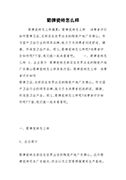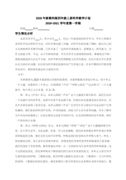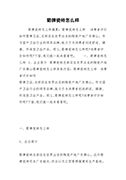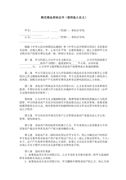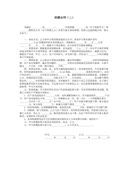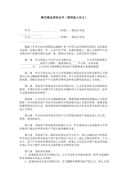Where is the post office(精选2篇)七年级英语教案
Where is the post office(精选2篇)
Where is the post office 篇1
unit 1 where’s the post office?
no. 110 middle school of chongqing by cao yi
teaching goal:
1. general aims:
a. ask for directions on the street
b. give directions on the street
2. particular aims:
a. language focus.
(1). ask the way on the avenue.
(2). show the directions on the street.
b. language goals
(1). is there a bank near here?
yes, there’s a bank on center street.
(2). where’s the supermarket?
it’s next to the library.
(3). is there a pay phone in the neighborhood?
yes, it’s on bridge street on the right.
(4). go down off the fifth avenue.
(5) . take a walk straight.
c. language structures:
(1). special question with where
(2). there be …. (pay attention to be singular or plural)
(3). preposition with position
(4). sentence with yes.
d. useful words and phrases:
words: hotel, bank, park, supermarket, street, avenue, new, clean, quiet, big, small, dirty, old, busy, left, right, near, pay
phrases: post office, video arcade, next to, pay phone, across from, between…and, turn left /right, go straight, take a walk, excuse me, go through, take a taxi, arrive at/in
e. grammar language:
(1). there be …
(2). where is the place?
(3). position preposition
f. learning strategies:
(1). using what you know
(2). inferring content
g. interdiscipinary:
(1). geography
(2). art
(3). society
h. emotion and manner:
(1). expression
(2). help others
teaching time: 6 periods
teaching procedures:
period one (p1)
step 1: warming up
1. greeting
first wish the class have a happy, healthy new year.
2. warming up
what do you do during the spring festival?
step 2 presentation
1. leading-in
for example: (say to myself)
i go to nanping park. i go down the shanhu avenue, there is a hotel, a bank, two pay phones and so. turn left and go straight to the jiefang street. it’s on my right.
draw a picture and write down some places on the blackboard as i am talking.
2. teaching the new words.
post office, video arcade, pay phone, bank, supermarket, hotel, library, street, straight, turn, left, right
step 3: practice
1. ask students to act out about turn left/right. (each team every time, at last only one who wins gets a award.)
2. section a 1a reading
ask ss to read the places and match the words with the pictures.
3. guess the place where i am.
for example:
i am standing here. (point to the picture) go down bridge street and turn left at the first crossing. go along fifth avenue. it’s on my right. it’s next to library. where am i going?
show them in the screen.
4. ask ss to follow the conversation above and complete the conversation.
5. have the line in the classroom as the street and desks as the buildings and practice the conversation above.
(1). teacher tells four students each time to act out, others judge if they walk in the street correctly.
(2) ask ss to judge “wrong” or “right”.
6. section a 1b listening
play the recorder, ask ss to circle the place they hear on the picture in 1a.
7. pairwork: have ss ask and answer the question following 1c about other places in picture.
step 4: homework
1. copy the words in 1a.
2. make a conversation like 1c.
step 5: classwork: translation:
1. 图书馆在超市的对面。 2. 公园在银行的旁边。
3. 超市在第五大街上。
4. 投币电话在电子游戏中心和超市之间。
design blackboard:
unit 1. where’s the post office?
1. is there a …near here? between … and…
2. where’s the …? next to
it’s on /across from … on the left /right
teaching note after class:
period two (p2)
step 1: revision
revise the words of 1a using the following pictures.
sixth avenue
step 2: presentation
1. teach these words using the pictures:
across from next to between…and on
2. help them make sentences with these words.
the hotel is across from the bank.
the cinema is between the hotel and the library.
video arcade is next to the supermarket.
step 3: practice
1. section 2a reading
get the students to read the sentences in the box first. then match each sentence with one of the pictures.
2. section a 2b listening and understanding
first read the words in the box together.
play the recording twice for the students to write down the words they hear.
play again, let the class know these conversations:
---where is …?
--- it is …
---is there a …?
---yes, …
3. section a 2c oral practice
let the students look at the picture of page 1.
ask and answer in pairs (or in a t-s way)
then ask several students to repeat some of their conversations for the class.
step 4 homework
1. copy and master the sentences in 2b.
2. finish sentences in 2b
step 5 classwork
1. choose the best answer:
(1). my best friend sits next _____ me.
a. to b. on c. in d. beside
(2). is _____ a bank near the library?
a. have b. there c. has d. there
(3). ---is there a bike in the supermarket? ---_______.
a. yes, it is b. no, it isn’t c. yes, there isn’t d. yes, there is
2. translation:
(1). 附近有一个公园吗?是的,在旅馆和邮局之间有一个。
(2). 公用电话在哪里?在学校的对边。
teaching note after class:
period three (p3)
step 1 revision
1. using a map of our school to revise the words of 2b.
2. revise the conversation:
---where is the …?
---it is ….
step 2 presentation
1. say: the post office, bank, supermarket are in my school’s neighborhood.
i am at school. i want to go to the bank. how can i get there?
teach the students to describe directions using the following: go/ walk straight, turn left /right, on the left /right, go /walk down the street
fore example: go straight and turn right. it’s on the jiefang street. it’s on the left. the bank is next to the supermarket.
2. practice:
ask the students to practice more description of directions. make sure they learn it well.
step 3 practice
1. section a 3a reading
have the students read the conversation together.
ask one of the students to put the conversation into chinese.
remind the students of the expressions in the table.
draw the route pointed by nancy and find out the position where nancy and paul are standing.
2. section a 3b writing
tell the class these three pairs are in the picture above and find them in it. the first pair is on the corner of the new street. the second pair is across from the first. the third pair is on the corner of the bride street.
ask the students to have a discussion first and then make sentences after the model of 3a.
step 4 game
practice using the target language:
---is it + position + place?
---yes, it is. / no, it isn’t.
let students look at the picture of p1 ask and give directions in groups of four.
step 5 homework
1. stabilities of the words.
2. make the sentences according the picture in 1a.
step 6 classwork
1. complete the conversation
a: excuse me, is there a bank ____(1) the neighborhood?
b: yes. just _____(2) straight and ______(3) left. it’s down the second avenue _____(4) the right. it’s next _____ (5) a post office.
a: ____(6) there a supermarket near it?
b: yes. it’s _____(7)from the bank.
a: thank you very much.
b: you’re ______(8)
2. make a sentence.
(1). the, neighborhood, is, a, post, office, in, there
__________________________________________________?
(2). next, the, to, it, is, library
____________________________________________?
(3). bank, is, a, pay, there, the, park, between, phone, and, the
________________________________________________________?
teaching note after class:
period four (pp4-5)
step 1 revision
1. revise the conversation of section a 3a
2. make sure they can use these phrase correctly.
go/walk straight, turn left /right, on the right /left
step 2 presentation
1. teach the following description words by the picture of section b 1a.
big /small, clean /dirty, busy /quiet/ noisy, new /old
2. section b 1a
read the words aloud.
say each word’s meaning.
then ask students to match each word or phrase on the list with one of the pictures.
step 3 practice
section b 1b
first, read the dialogue together.
second, work in pairs according to the model.
ask some students to present their dialogues for the class.
step 4 listening
1. play the recording the first time, ask students to circle the places they hear in 1a.
check answer. (shorten)
2. play it again. this time draw a map of micheal’s neighborhood in the box.
step 5 pairwork
1. let students show the maps of their family houses.
then tell their partners where they live.
2. ask one or two students to talk about their family locations in class, the other students draw maps of their families.
3. check if the maps are correct.
step 6. reading
1. reading the passage by themselves and find out the new words or the points they can’t understand.
the new words: garden district take a walk through pass beginning tour
2. read the passage together. ask them to circle the description words.
3. read after the tape and then read it together.
step 7. homework
1. use the old words to describe your own house
2. complete the passage in 3b
step 8. classwork
1. write the following forms
(1). dirty(opposite) (2). beginning (v) (3). tour(job)
(4). pass (past form) (5). old(opposite) (6). visit (gernous)
2. change into english
1.玩得高兴 2. 在长椅上 3. 一家古老的旅馆
4. 在你住的附近 5. 一条繁忙的街道 6. 散步
3. written
describe your neighborhood and draw a map of it
teaching note after class:
period five (pp5-6)
step 1 check
check the students’ dialogues and maps.
step 2 reading and writing
1. students look at the picture of 3b. ask them to describe the picture.
2. let students read the passage of 3b and fill in the blanks.
show the correct answers (shorten)
3. if necessary, explain some difficult points:
have fun =have a good time busy be busy v-ing sth or with sth enjoy sth, enjoy v-ing sth, enjoy oneself if
step 3 revision
shelf check 1
1. read aloud together
then talk about their meaning one by one
find out their opposite of the words in 1
2. reading and drawing
have the students read the e-mail by themselves. find out the new words in the passage.
words: airport, pass, arrive, yours taxi
phrase: take a taxi, turn left, on your right, go through
try to understand the meaning of the e-mail
get the students to draw the route from the airport to mike’s house.
check answers.
ask the students to read e-mail together.
step 4 just for fun
read the dialogue in two halves.
question: who breaks the mobile phone?
step 5 homework
do the study guide in chongqing
teaching note after class:
period six
testing (weekly paper and nan’an paper)
note:
Where is the post office 篇2
unit 2 where’s the post office?
teaching aims:
functions: ask for and give directions on the street
structures: there be structure
where questions
affirmative statements
prepositions of place
difficulties and focus:
target language: is there a bank near here?
yes, there is. it’s on center street.
where’s the supermarket?
it’s next to the library.
is there a pay phone in the neighborhood?
yes, it’s on bridge street on the right.
vocabulary: post office, restaurant, bank, supermarket, avenue, pay phone, park, dirty, clean, left, right, next to, across from, near, between, in front of, behind
recycling: hotel, street, new, big, small, busy, do you want to…?
learning strategies: using what you know
deducing
personalizing
section a
create plots and scenes to guide the new lesson
the main content is to learn to ask for and give directions in conversations by introducing some buildings in section a, so we can adopt the audiovisual guiding method: at first, review the prepositions that the students have learned, and then the teacher can teach some nouns about buildings by showing some pictures or projecting flashcards about some buildings.
1. show a picture of a bank.
t: look at this picture. what place is it?
s: it is a bank.
t: spell it.
s: b-a-n-k.
teach other new words: post office, park, supermarket, and payphone, street.
show a map and let students practice in pairs.
is there …… ?
yes, there is. /no, there isn’t.
2. consolidation:
tell us the way to your school.
t: where is the …?
s: it’s ….
teach the prepositions
next to, across from, near, between, in front of, behind.
step1: .learn some nouns about buildings first, and then the teacher communicates with the students.
show some pictures about buildings or project some flashcards about buildings.
t: it’s a bank.
can you spell it?
s: yes i do. / no, i don’t.
t: is there a / an…?
s: yes, there is. / no, there isn’t.
t: where is the…?
s: it’s near/ next to /across from /… the…
step2: get the students to practice conversations and communicate with each other.
is there a / an … near here? yes, there is.
where’s the …? it’s … .
step 3: 1. play the tape of part 1b, get the students to listen and circle the places they hear in 1a, finish the teaching task of 1b.
the answers in 1a are: f, a, e, i, c, b, h, g, d.
the answers in 1b are: restaurant, post office, supermarket, fifth avenue, bridge street, center street.
2. 1c: this activity provides guided oral practice using the target language:
point to the different locations shown in the picture. ask different students to name each one.
point to the question and answer the example conversation and ask a pair of students to read the conversation to the class.
ask students to work in pairs. say, first one person a question and then the other person takes a turn.
demonstrate the activity. point to the picture and ask, is there a post office near here? then choose a student to answer. guide the student to say, yes, there’s a post office on bridge street.
as students work, move around the room and check on their progress.
ask students to present their questions and answers to the class.
3. 2a: the answers are: 4, 6, 2, 3, 5, 1.
4. play the tape of part 2b, and get the students to fill in the blanks with the words in the box, finish the teaching task of part 2b.
the answers are: 1.between, 2.across from, 3. on, 4. next to, 5. in front of, 6. behind.
5. 2c: this activity provides guided oral practice using the target language.
point to the list of buildings in 1a. ask a student to read the list aloud.
point to the question and answer in the speech bubbles in 2c and ask a pair of students to read the conversation to the class.
ask ss to work in pairs like in 1c.
demonstrate the activity. point to the map and ask where’s the park? then choose a student to answer. guide the student to say, it’s across from the bank.
5. 3a: this activity provides target-oriented reading practice using the language items taught in this unit.
draw attention to the conversation in the box.
ask a student to point out the place that paul wants to get to.
point to the two arrows. ask students to repeat left and right.
ask ss to read the conversation again.
the answer is: paul and nancy are the two figures outside the gate to the park.
6. 3b: this activity provides guided writing practice using the target language.
call attention to the three pictures.
point to the questions below each picture and ask a student to read them aloud.
point to the three write-on lines in the speech bubbles.
ask students to complete the writing individually.
answers are: 1). yes, there is. go straight down new street and turn right. there’s a pay phone on the right.
2). go straight down new street and turn right. turn left at bridge street. the bank is across from the street.
3). yes, there is. turn right, and then go straight down bridge street. the post office is on the left. it’s across from the restaurant, next to the supermarket.
7. part 4 provides guided oral practice using the target language.
section b and self check
create plots and scenes to guide the new lesson
review and consolidate the sentence patters like is there a / an …? where’s the …? where do you live? by reviewing and learning some nouns about public buildings in section b. the transforming information methods can still be adopted: the teacher shows some objects or pictures or projects some flashcards and gets the students to do pairwork to review the words taught in the first part; again the teacher shows some objects or pictures or projects some flashcards about public buildings, for example, a park, a hotel, a street, a supermarket. at last, the teacher can get the students to observe the pictures in part 1a and match the pictures with the words, then finish the teaching task of part 1a.
the main content in section b is to ask for and give directions on the street with the target language learnt.
step 1: demonstration
the teacher communicates with the students to review the target language:
is there a / an…? yes, there is. / no, there isn’t.
is there a / an … near where you live? yes , there is.
where is the ….? it’s… .
step 2: activities
get the ss to practice conversations to review the target language:
is there a /an…near where you live?
yes, there is.
step 3: intercourse
get the ss to write a guide for their town and let them communicate with each other, then draw a picture of where their partner lives:
where do you live?
my house is… .
step 4: experiences
play the tape of part 2a and get the ss to circle the places they hear in activity 1a. then finish the teaching task of part 2a.
again play the tape of part 2a and get the ss to draw a map of michael’s neighborhood in the box according to the content they hear, and then finish the teaching task of part 2b.
the answers in 1a: e, d, a, g, f, h, c, b.
the answers in 2a are: a quite street, a new hotel, a small supermarket.
step 5: activities
get ss to do groupwork and review the words in 1a, lead student a to say one true thing and one false thing about his or her map in 2b, and another student to say yes or no, and finish the teaching task of part 2c.
step 6: read by themselves
get the ss to read the passage in part 3a and demand them to circle the description words: busy, small, old, interesting. then finish teaching task of part 3a.
step7:
get the ss to look at activity 3a, and look at the picture in 3b and fill in the blanks, then finish the teaching task of part 3b. demand the students to use some description words in 3a.
step 8:
get the students to write a guide for their town, and finish the teaching task of part 3c.
step 9: get the ss to do pairwork, demand the ss to describe where they live, let them to draw a picture according to their partners’ description, and finish the teaching task of part 4.
summary:
the content of this unit is to learn some nouns of public buildings and prepositions of location, the sentence patterns like is there a /an…? where is the …? and to learn how to talk about the places and their locations.


